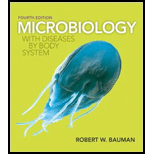
Microbiology with Diseases by Body System (4th Edition)
4th Edition
ISBN: 9780321918550
Author: Robert W. Bauman Ph.D.
Publisher: PEARSON
expand_more
expand_more
format_list_bulleted
Question
Chapter 22, Problem 8SA
Summary Introduction
To answer:
On what basis, antigens are selected for the flu vaccine in the United States each year.
Introduction:
Influenza virus is the common cause of flu, which has two strains, namely A and B. This infection has symptoms like headache, fever, pharyngitis, dry cough, congestion, and muscle pain.
Expert Solution & Answer
Want to see the full answer?
Check out a sample textbook solution
Students have asked these similar questions
What is the structure and function of Eukaryotic cells, including their organelles? How are Eukaryotic cells different than Prokaryotic cells, in terms of evolution which form of the cell might have came first? How do Eukaryotic cells become malignant (cancerous)?
What are the roles of DNA and proteins inside of the cell? What are the building blocks or molecular components of the DNA and proteins? How are proteins produced within the cell? What connection is there between DNA, proteins, and the cell cycle? What is the relationship between DNA, proteins, and Cancer?
Why cells go through various types of cell division and how eukaryotic cells control cell growth through the cell cycle control system?
Chapter 22 Solutions
Microbiology with Diseases by Body System (4th Edition)
Ch. 22 - Prob. 1TMWCh. 22 - Why must diphtheria immunization be boosted every...Ch. 22 - Why is it inappropriate to treat a cold with...Ch. 22 - Prob. 1CCSCh. 22 - Prob. 4TMWCh. 22 - Prob. 1EDCSCh. 22 - Prob. 2CCSCh. 22 - Prob. 3CCSCh. 22 - Prob. 5TMWCh. 22 - Prob. 2EDCS
Ch. 22 - Outbreaks of blastomycosis have occurred in Latin...Ch. 22 - Prob. 1MCCh. 22 - Prob. 2MCCh. 22 - Prob. 3MCCh. 22 - The glycoprotein spikes on influenzaviruses are...Ch. 22 - Prob. 5MCCh. 22 - Prob. 6MCCh. 22 - Prob. 7MCCh. 22 - Prob. 8MCCh. 22 - Prob. 9MCCh. 22 - Prob. 10MCCh. 22 - Prob. 1FIBCh. 22 - Prob. 2FIBCh. 22 - Prob. 3FIBCh. 22 - Fill in the Blanks 4. A drug commonly used to...Ch. 22 - Prob. 5FIBCh. 22 - Prob. 1MTFCh. 22 - Prob. 2MTFCh. 22 - Prob. 3MTFCh. 22 - Prob. 4MTFCh. 22 - Prob. 5MTFCh. 22 - Prob. 1VICh. 22 - Identify the following bacteria discussed in this...Ch. 22 - Prob. 1SACh. 22 - Prob. 2SACh. 22 - Prob. 3SACh. 22 - After listening to a lecture on diseases caused by...Ch. 22 - Prob. 5SACh. 22 - Prob. 6SACh. 22 - Prob. 7SACh. 22 - Prob. 8SACh. 22 - Prob. 9SACh. 22 - Prob. 10SACh. 22 - Prob. 1CTCh. 22 - An elderly man is admitted to the hospital with...Ch. 22 - Compare and contrast viral pneumonia with...Ch. 22 - Prob. 4CTCh. 22 - Prob. 5CTCh. 22 - Compare and contrast antigenic drift and antigenic...Ch. 22 - In mid-November, a worried couple brought their...Ch. 22 - Prob. 8CTCh. 22 - Prob. 9CTCh. 22 - Prob. 10CTCh. 22 - Prob. 11CTCh. 22 - Prob. 1CM
Knowledge Booster
Learn more about
Need a deep-dive on the concept behind this application? Look no further. Learn more about this topic, biology and related others by exploring similar questions and additional content below.Similar questions
- In one paragraph show how atoms and they're structure are related to the structure of dna and proteins. Talk about what atoms are. what they're made of, why chemical bonding is important to DNA?arrow_forwardWhat are the structure and properties of atoms and chemical bonds (especially how they relate to DNA and proteins).arrow_forwardThe Sentinel Cell: Nature’s Answer to Cancer?arrow_forward
- Molecular Biology Question You are working to characterize a novel protein in mice. Analysis shows that high levels of the primary transcript that codes for this protein are found in tissue from the brain, muscle, liver, and pancreas. However, an antibody that recognizes the C-terminal portion of the protein indicates that the protein is present in brain, muscle, and liver, but not in the pancreas. What is the most likely explanation for this result?arrow_forwardMolecular Biology Explain/discuss how “slow stop” and “quick/fast stop” mutants wereused to identify different protein involved in DNA replication in E. coli.arrow_forwardMolecular Biology Question A gene that codes for a protein was removed from a eukaryotic cell and inserted into a prokaryotic cell. Although the gene was successfully transcribed and translated, it produced a different protein than it produced in the eukaryotic cell. What is the most likely explanation?arrow_forward
- Molecular Biology LIST three characteristics of origins of replicationarrow_forwardMolecular Biology Question Please help. Thank you For E coli DNA polymerase III, give the structure and function of the b-clamp sub-complex. Describe how the structure of this sub-complex is important for it’s function.arrow_forwardMolecular Biology LIST three characteristics of DNA Polymerasesarrow_forward
arrow_back_ios
SEE MORE QUESTIONS
arrow_forward_ios
Recommended textbooks for you






Infectious Diseases - How do we control them?; Author: Let's Learn Public Health;https://www.youtube.com/watch?v=2JWku3Kjpq0;License: Standard Youtube License